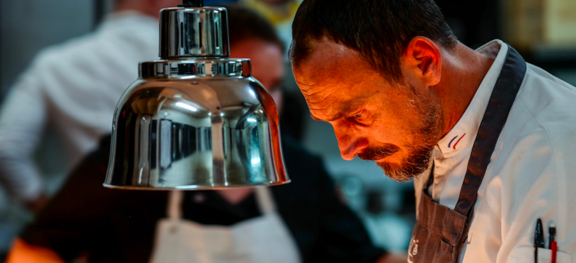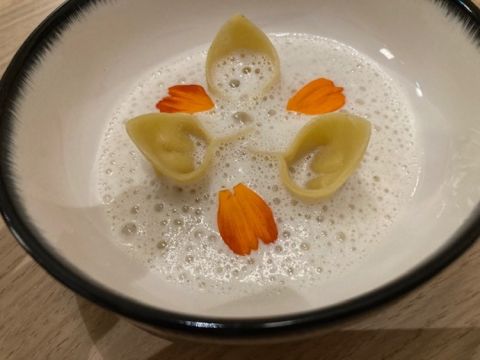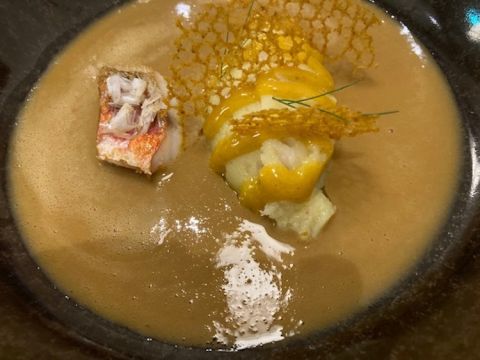Dining out in Narbonne

We go posh.
The great advantage ‘the masked’ have over ‘the unmasked’ became immediately obvious after we had walked through the reception area of La Table Lionel Giraud (until recently La Table de St Crescent) on the outskirts of Narbonne. Here we had ourselves unmasked and we had each been given a perfumed towel, before being led through to our corner table.
‘Good evening, Mrs Robinson, and how nice to be able to serve you both again’, came the voice of a bearded, besuited, masked man. We looked perplexed because it was impossible to recognise someone fully masked as he continued, ‘I served you some time ago at Hedone in Chiswick about which you wrote a very nice article in the FT’. We lamented this restaurant’s closure before he went away to bring us a bottle of water.
As he did so, we took in our surroundings which were not entirely new to us. Twenty years ago the building which today houses Lionel Giraud’s two-star Michelin restaurant La Table was known as Le Palais du Vin, one of the best wine shops in the area. Because this was set up to promote the wines of the Languedoc, it received government backing, and Lionel’s father, Claude, was involved in the restaurant before handing over culinary control to his son. A redesign that should have seen the restaurant open in the spring was delayed by various factors and it finally opened its doors on Bastille Day, 14 July.
The redesign keeps the high ceilings (the building in the Middle Ages was originally an abbey), which means the acoustics are extremely good and there is considerable space between the tables. There is also great emphasis put on ensuring that you honour your reservation. We received no fewer than five emails from the restaurant regarding our booking, four beforehand and one after, seeking our feedback!
When our friend had settled in and he and Jancis were enjoying a glass of Fleury’s Fleur de l’Europe champagne (€18 each; I was driving!), we turned to the menus that were lying on the table addressed to two Mr Robinsons. These in design and detail were so original that I wish I had been able to include them in my book On The Menu, which Unbound are just about to republish as a paperback.
The menu was lying in a black folded document, and facing upwards was a map of Occitanie, the massive administrative region created in 2014 that comprises almost six million people and stretches from the Hautes-Pyrénées in the south-west to Gard in the east, up to Lot in the north and runs along a long stretch of the Mediterranean. This vast region provides all the ingredients for La Table’s kitchen. On the back are the two dinner prices, seven courses for €90 and €130 for 11, and the whole unfolds to list 32 different dishes under several headings: prémices, séquence graminée, séquence végétale et marine, séquence animale, and, ultimately, séquence laitière et sucrée.
This is simultaneously a style of service that I have never seen before but one that I would not like to see another chef copy.
Our waiter quickly reappeared and, having ascertained that the seven-course option would be quite enough for us, immediately dispelled any notion of choice. ‘The kitchen will decide’, was his response. So why were so many other dishes on offer, I wondered? There were lots of dishes listed that intrigued me – a tuna dish, a civet of octopus, fagottini of lamb with Pyrenean garlic, and wild strawberries with verveine were just some of these. We undoubtedly ate very well but I went away with a soupçon of disappointment at all those treasures advertised but not delivered. Not surprisingly, the service was swift and efficient but the kitchen was undoubtedly in control throughout. The waiting staff are reduced to smiling, courteous plate-carriers and there is no frisson of excitement, or envy, at seeing what those at other tables had ordered because we all ate the same menu. This was a feeling reinforced by their approach that every, or certainly most, tables seemed to have been asked to book for 8.15 pm.
We began with the kitchen’s liquid ‘olive’ and then a small bowl of a delicious mushroom concoction before a bowl of very sweet, liquid onions and a round of ‘pain vapeur’, their variation on a steamed bread bao. Then we moved on to our second course, corn tortellini with almonds three ways (above): whole, as a milk, and as a stuffing in the tortellini. This was absolutely first class.
Next up was a small aubergine, served whole but peeled and cooked, on which had been delicately placed a small piece of lightly grilled mackerel, but what was alongside this combination was even more intriguing. It was described as a smoked sabayon of pine nuts from nearby La Clape and was absolutely heavenly: rich but without being creamy, light and moreish (see below).
This was followed by another excellent fish dish (below, half-eaten), small pieces of smoked hake, topped with turnips, a combination which managed to make this not only my favourite dish of the evening but also, according to our waiter, his own favourite dish on the entire menu (I find it always comforting to hear this).
This was followed by our final fish dish described as a brandade of red mullet (below), around which a bouillabaisse was gently poured, but for me the highlight was the thin squid scales on top of the brandade itself. Then on to our main course, a small piece of matured, eight-week-old Aubrac beef topped with a mound of local caviar from St-Guilhem-le-Désert. This was definitely a rich, if perhaps less provocative, combination.
There was no question of whether we wanted cheese, as two wooden blocks – to remind us that we are in a fire-risk area – quickly appeared carrying three cheeses, a small goat’s cheese, a tomme from mountain sheep and some excellent Roquefort, served alongside a well-dressed bowl of green salad.
Then came dessert. At this point in the meal, as three waiters descended on our table with bowls and plates of various descriptions, I will hand over to our old friend James Herrick, born in England but who has lived in Narbonne for the past 30 years, for his very apt comment. ‘Aren’t the French lovely?’ he asked no one in particular, ‘You order seven courses and they bring you 11 desserts!’
Well, they may not have been 11 but there were certainly five: a wonderful, cool, pot of an almond and white chocolate cream that came in a cleverly iced dish; a fig, very seasonal, over which verveine was poured; another milk dessert, very pretty, with blue vanilla; a madeleine; and three chocolate Valrhona creations that were barely touched. With a bottle of Corsican white, a 2018 Vermentino, Hauts de Carco from Domaine Antoine Marie-Arena (€59), my bill came to €375 for the three of us.
I left La Table impressed by the culinary dexterity of the kitchen and its ambition and inspiration. I would not want to return for a couple of years but this criticism is offset by the presence next door of his less ambitious but much more relaxed Cave à Manger bistro with much outdoor seating. (Our interior was quite aggressively air conditioned.) But together, they constitute an attractive addition to this city.
La Table Lionel Giraud, Maison Saint-Crescent, 68 avenue Général Leclerc, 11100 Narbonne; tel +33 (0)4 68 41 37 37. Open Wednesday to Saturday, lunch and dinner, and Sunday lunch.
La Cave à Manger, Maison Saint-Crescent; tel +33 (0)4 68 45 67 85. Open seven days a week, lunch and dinner.
Become a member to view this article and thousands more!
- 15,415 featured articles
- 274,304 wine reviews
- Maps from The World Atlas of Wine, 8th edition (RRP £50)
- The Oxford Companion to Wine, 5th edition (RRP £50)
- Members’ forum
- 15,415 featured articles
- 274,304 wine reviews
- Maps from The World Atlas of Wine, 8th edition (RRP £50)
- The Oxford Companion to Wine, 5th edition (RRP £50)
- Members’ forum
- Commercial use of our Tasting Notes





